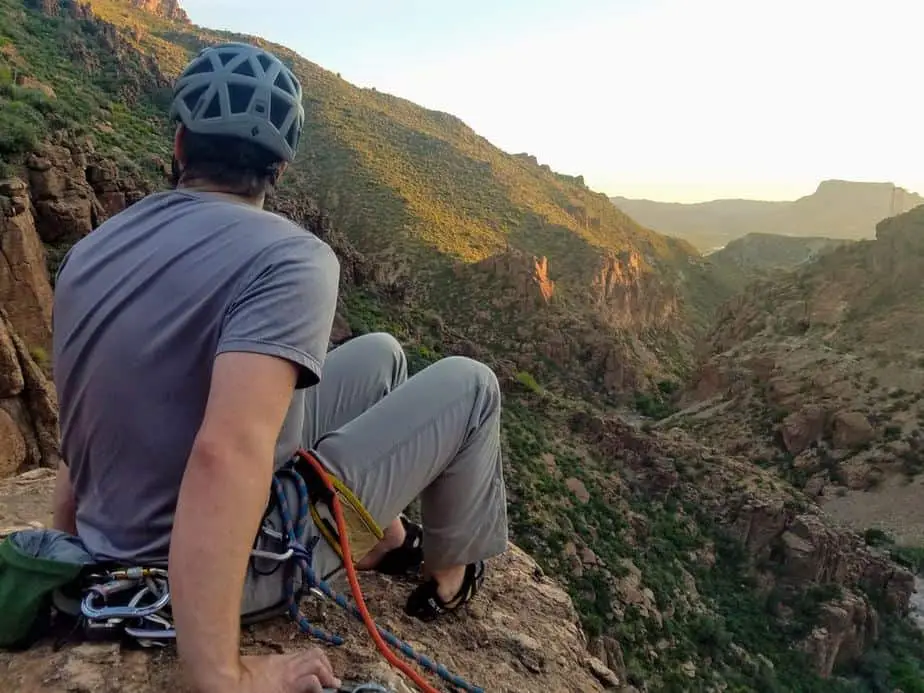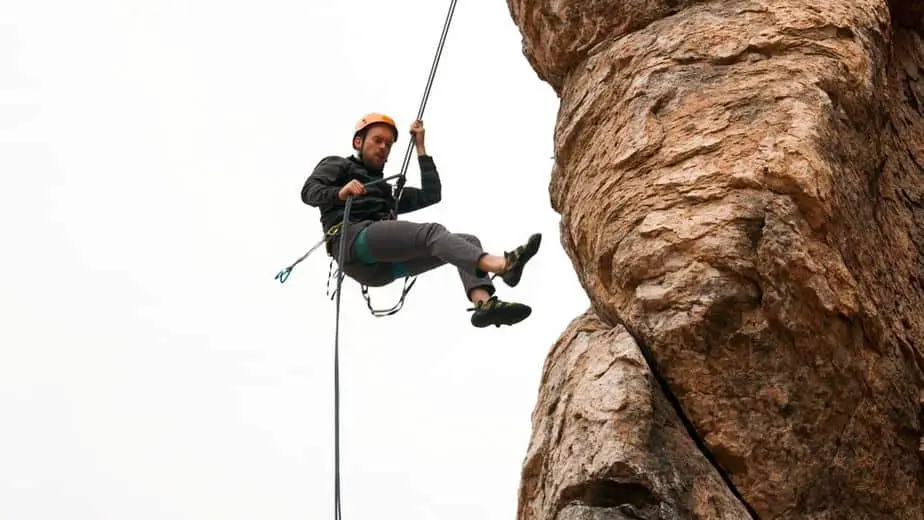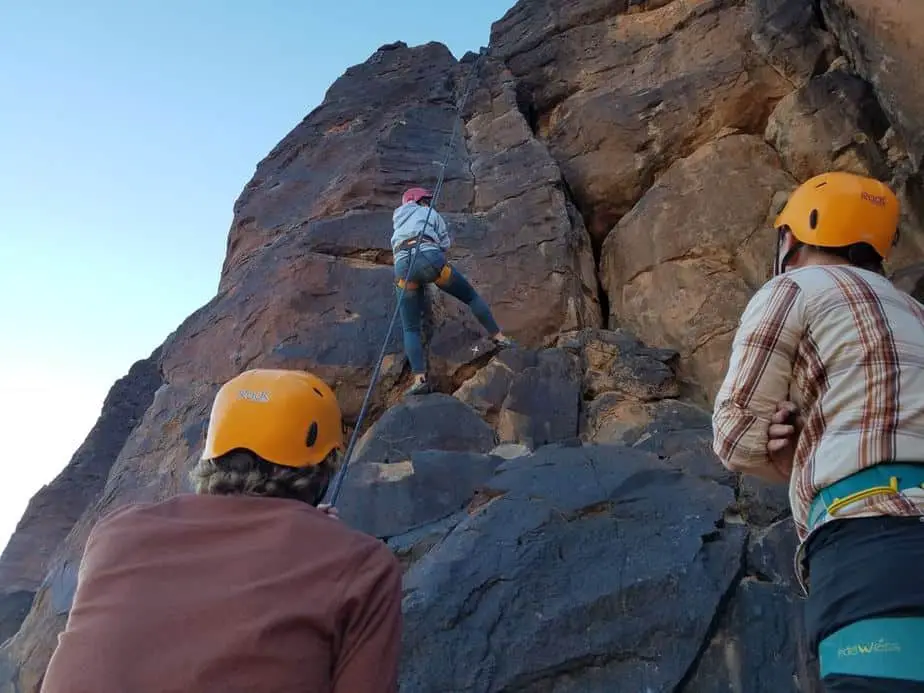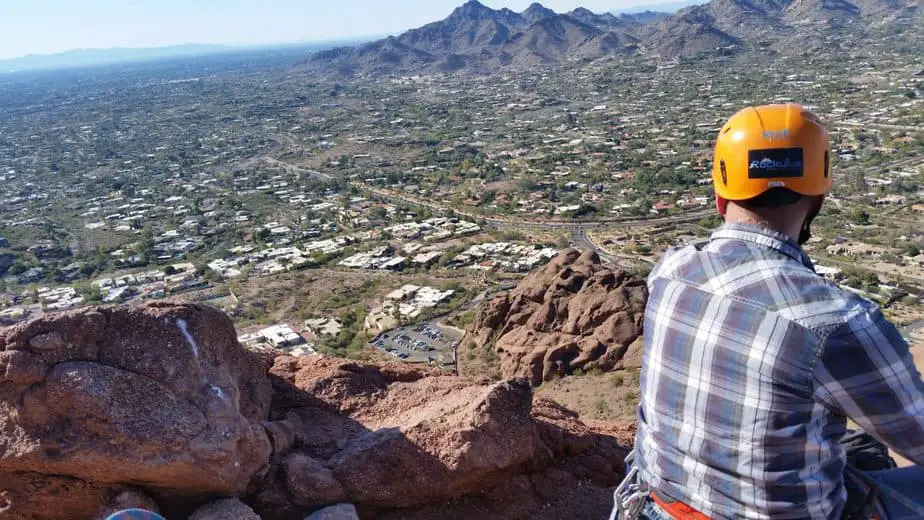Does what you wear outside really matter? Climbing pants aren’t necessary to climbing like a harness or climbing shoes, but they can definitely make the day more comfortable and protect your legs and knees from painful scrapes and bruises. They also lend a lot of “street-cred” to a climber, and make you look pretty serious and invested. They do cost a lot more than regular pants, so you need to know what your needs are.
The main advantages to climbing pants are durability and flexibility. If you have another pair of pants that meets those needs, you can go without; however, climbing pants are specifically designed and engineered to take the abrasive beating inherent to rock climbing and canyoning, and to go wherever you go without limiting your reach at all. You can usually find a good pair of climbing pants on sale for a decent price, and they generally last a long time.
For the casual climber, who climbs only in the gym or a few times per year, climbing pants are more of a fashion statement than anything. If you climb a few times per week or per month, or spend a lot of your time climbing outdoors, then climbing pants are definitely worth it. Some people even refer to them as ‘Aid!’ Climbing pants also are great for a ton of other activities like hiking, camping, and canyoneering .
.
What are the Best Climbing Pants?
Between my experience climbing, as well as a lot of time researching on Mountain Project and Reddit, prAna’s Stretch Zion pants (prAna Halle Pant  is the women’s version) are hard to beat. While there are many different climbing pants out there, these are hands-down the most beloved. They cover all the bases in terms of comfort, flexibility, and durability, and are still nice enough to wear around town. There’s a full analysis of these pants further ahead.
is the women’s version) are hard to beat. While there are many different climbing pants out there, these are hands-down the most beloved. They cover all the bases in terms of comfort, flexibility, and durability, and are still nice enough to wear around town. There’s a full analysis of these pants further ahead.

What are the Advantages to Climbing Pants?
Climbing, especially bouldering, often requires you to use special techniques like heel hooks in order to ascend a wall. In a regular pair of jeans or cotton pants your reach will be severely limited because of the rigidity of the material.
You can wear something like leggings for climbing indoors, where abrasiveness is minimal, but when climbing outdoors the rock can tear right through them! (if you do wear leggings, make sure they’re thick enough that they don’t become sheer when you’re stretching your foot up by your hand for the perfect hook)
Climbing pants are durable enough to withstand a good amount of sliding and digging into rocks without pilling or getting shredded through. Obviously they will wear out with time, but they should last a lot longer than regular pants. A lot of climbing pants have reinforced seats and knees, as those areas tend to see the most action.
Not only is the material for climbing pants slightly stretchy, but the pattern is designed so as not to limit specific areas like your thighs and crotch. Most men’s climbing pants have a gusseted crotch, which just provides more space and is less restrictive when stretching for holds.
Another feature common to most climbing pants is that the waist and length are usually adjustable. The length can be adjusted with either elastic cuffs on the pant legs or some sort of snap. This way you can pull them up and turn them into capris or shorts on hot days, and they don’t interfere with your footwork.
Many climbing pants have a built-in belt so you can adjust the waist throughout the day. A regular belt can be uncomfortable under a harness.
A climbing harness renders most regular pants pockets unusable. Climbing pants are usually designed so that the pockets are in slightly different places where your harness won’t cover or bunch up. Additionally, climbing pants have zipper, or other methods of closure so that stuff won’t fall out as you dangle upside down.
What are the Disadvantages to Climbing Pants?
The main disadvantage to climbing pants is the price point. On average, climbing pants cost around $80 USD, which is 3-4 times what you probably usually pay for pants. Fortunately, you can usually find them on some kind of sale.
It’s a lot of money for a pair of non-essential climbing gear, especially after you’ve paid for all of the other gear you need. The decision of whether climbing pants are worth it or not will depend how often you go and what styles of climbing you’re involved in.
The other main problem with climbing pants is more of a historical problem. In the past, climbing pants were really baggy and coarse, and just didn’t look very sharp. For those who cared, they couldn’t go from work to the gym/crag, or couldn’t go from the gym/crag to get dinner.
In recent years however, as styles have shifted and climbing gear has developed, climbing pants fit right in pretty much anywhere you go. Some can even fit in as business casual. If you do go for a skinnier pair of climbing pants, make sure you get a good pair that stretches a lot.
See also: How much does Rock Climbing Cost?
What to Look for in Climbing Pants
The first question you need to answer is what style of climbing you generally do. For gym climbing, you want something comfortable and stretchy that you can wear around regular people to and from the gym. For chimneying and off-widths, you need very durable, thick pants. Everything else falls somewhere in between.

Material: Climbing pants need to be durable, as well as stretchy. You want a pair that is primarily made out of a durable material like nylon (or even, heaven forbid, cotton), but with enough spandex or other elastic material that they stretch with you. Beware of cotton in the wild, as it absorbs and holds water. For reference, the prAna Stretch Zion Pants are 97% nylon and 3% spandex.
Fit: Where your pants fit on the fashion to function continuum will depend on your personal preferences. For guys, you definitely want a pair with a gusseted crotch, which just provides a lot more space to move around in and will be much more comfortable.
Adjustable Waist: As mentioned above, you want a pair of pants that can be worn without a belt but can also adjust with your waist. Get a pair of pants with a built-in belt that isn’t so big that it becomes uncomfortable when weighted in a harness. Big wall climbers, and even day climbers can lose enough weight that they drop by a size or two.
Adjustable Length: Though you can buy a pair of pants that go down to your mid-calf (and get asked “where’s the flood?”), the more convenient way is to change the length of your pants on the fly. There are two main ways to adjust the length of your pants. You can either buy a pair of convertible pants (zip-offs), or get a pair with elastic cuffs or snap cuffs.
Zip-offs are kind of dorky (says my wife), but wholly functional- especially when they also have an elastic or snap cuff. It’s nice to be able to change the length based on the weather as the day heats up.
Pockets: Make sure that the pockets are usable while you’re wearing a harness. It may not seem all-important to have pockets, but it can be nice to stash a phone or toothbrush in. Pockets should securely close so stuff doesn’t fall out on your belayer!
in. Pockets should securely close so stuff doesn’t fall out on your belayer!
Recommended Climbing Pants
prAna Stretch Zion (Women’s: Halle)
As explained above, these pants are the most popular among climbers, and rightfully so. They’re extremely breathable with a vented crotch area, they roll up & snap to adjust the length, and have a cargo pocket that’s accessible while climbing.
The waist is adjustable with a built-in belt, and the nylon/spandex combo is both durable and stretchy. prAna has made a few changes over the years to the design, but overall they’ve remained the best pair of climbing pants out there.
The only complaint I’ve really heard is that they’re so breathable that you can get cold (not a problem for me in Arizona!). prAna makes a convertible zip-off version of these pants too, that’s sometimes even cheaper.
Amazon: prAna Men’s Stretch Zion Pant , prAna Stretch Zion Convertible Pant
Amazon: prAna Women’s Halle Pant , prAna Halle Convertible Pant
Other Recommendations:
These pants are more designed for cold weather climbing and light mountaineering, but work pretty well. They have similar features to the others, except these don’t have a built-in belt.

These are a little bit lighter weight, but don’t have a built-in belt. All-in all, they’re a great option as well. Outdoor Research makes some really cool gear.

Can you Rock Climb in Jeans?
Some climbers actually like climbing in jeans because they’re generally pretty thick and durable and do a good job protecting your legs from abrasive rocks. No one is going to stop you if you try to climb in jeans, but there are some definite downsides to doing so.
The number one problem is that regular jeans are made from cotton. Cotton really doesn’t stretch very much, which will limit your flexibility. Make sure there is plenty of room in the crotch area so that you can reach around. You don’t want to blow a hole in them while climbing.
Jeans usually don’t breathe very well, and will be heavier than nylon pants for climbing. They say that ‘cotton kills’ in the outdoors since cotton absorbs and holds water when it gets wet. Keep that in mind when wearing cotton on overnight trips or in suspect weather, but it’s not an issue for most situations.
prAna actually makes a pair of jeans specifically for climbing that are 1% spandex so they stretch just enough to move around comfortably (prAna Aziom Jeans ). Climbers really like them since they look just like regular jeans. The downside is that they don’t have a lot of the other features other serious climbing pants have like thigh pockets and snap cuffs.
). Climbers really like them since they look just like regular jeans. The downside is that they don’t have a lot of the other features other serious climbing pants have like thigh pockets and snap cuffs.


